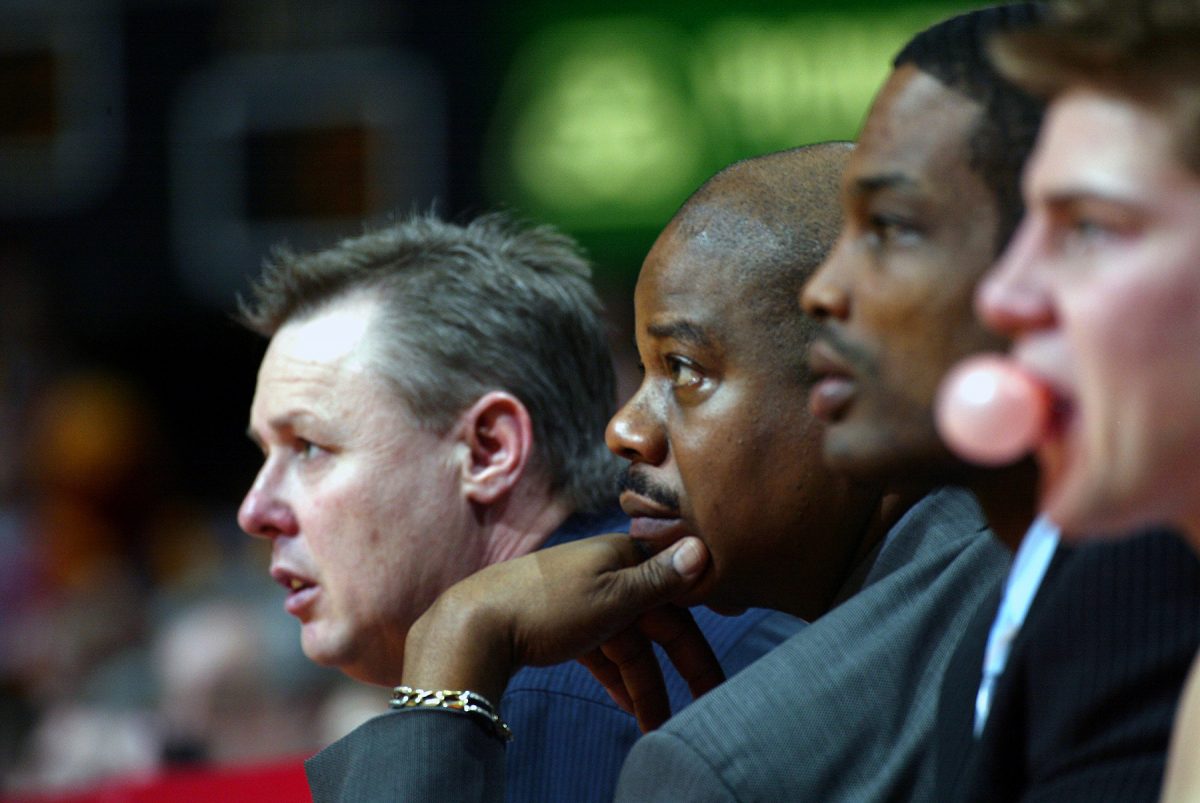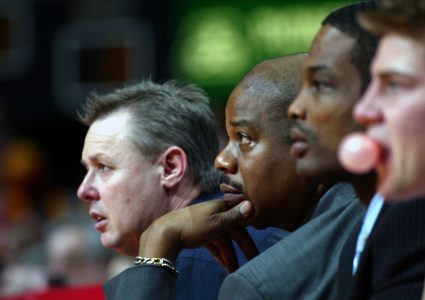Wayne Morgan faced the band of rambunctious students, then wondered, “What did I get myself into?”
In the early 1970s, the future Iowa State basketball coach cradled twin goals as be began his sixth-month student teaching stint in New York: Teach and coach.
Really, he’d be combining the two — and was content in doing so at the high school level, until that fateful day when he stood in front of that chalkboard and confronted chaos.
“This was a third-grade class,” said Morgan, who now works for New York Life as a financial professional. “(The regular teacher) introduced me to the class and said, ‘This is going to be your student teacher,’ and he waked out and I never saw him again until the semester was over. True story. Never came back one day. Just through that experience I said, ‘No, I don’t want to coach young kids.’ Because it’s like, ‘Mary, Mary, stop that,’ or, ‘John, what are you doing? Mary, I thought you stopped.’ You just couldn’t get them to do anything, so that’s why I coached in college because I said at least they’ll understand what I’m trying to do.’”
Morgan — whose coaching career threaded through his home state of New York, to Long Beach, Calif. and Ames — laughs as he recounts that story. He’s truly living life with no regrets. He still loves the game of basketball, but he’s back in the city he came from and also adores: New York.
“I love watching the game,” said Morgan, who took over the Cyclones’ top job in 2003 after Larry Eustachy was fired amid controversy stemming from published photos depicting him partying with college students on road trips. “Other than that, I spend all my time working at what I’m doing. I’m trying to do that well and take care of my family.”
How’s that going?
“I’m not super-rich, but I’m paying our bills,” said Morgan, who led ISU to the NIT Semifinals and a second-round NCAA Tournament appearance in his three seasons at the helm. “In fact, I have a few clients who are in Iowa.”
Chaos. Calm. Resolve. Morgan has navigated through various states of affairs — often difficult ones — his whole life.
He respectfully declined to comment on the circumstances that surrounded his eventual dismissal in Ames after the 2005-06 season, choosing to focus instead on the achievements of his teams and the relationships he built that stand tall to this day.
“If you can do something you love and you can work with people that you love, there’s nothing better than that,” Morgan said. “So it was a great, great time. I met great, great people. The people of Iowa are still some of the greatest people I’ve ever met and I really don’t think there’s anywhere in America that has a better fan base than Iowa State. I see other people claim to have it, but if you watch the Big 12 Tournament and Iowa State people, or you see an Iowa State game, I don’t think anybody has that.
“And I think the difference is probably (many) of those fans are farmers but they’re very sophisticated. They understand the game. They understand what’s needed. The first year I was there we were 17-1 at home and I believe the crowd won five or six of those games. I really believe (that). The crowd would yell so loud at the other team that they couldn’t function and then they would cheer us on so hard that we knew we had to be successful. Literally, I think that crowd won five or six games.”
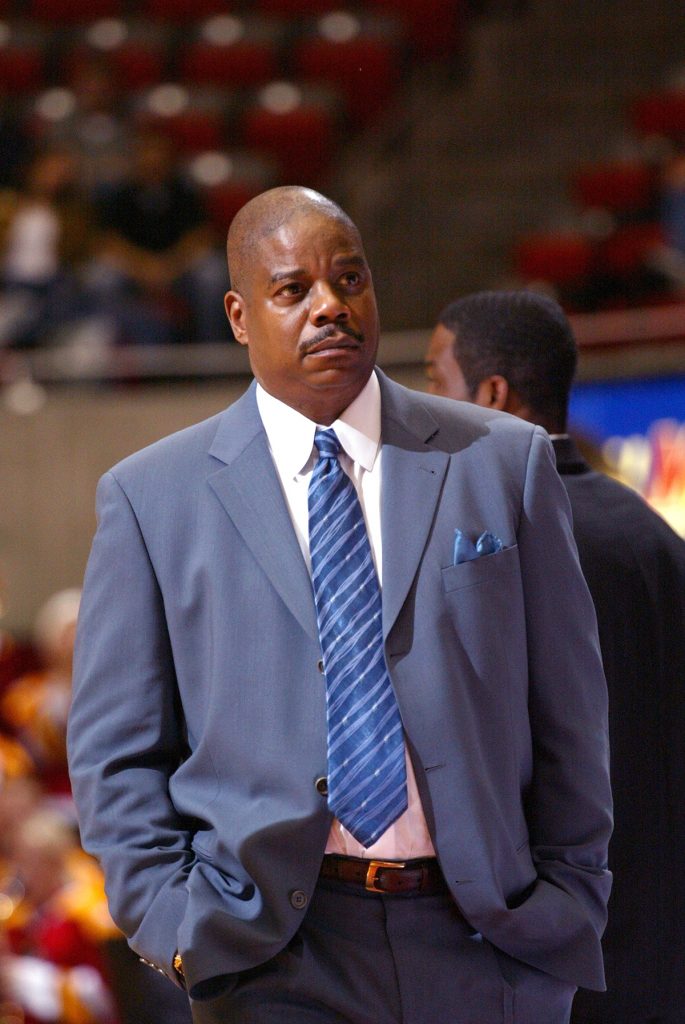
**FROM UPSTART TO HEAD COACH
The student teaching experience compelled Morgan to recalibrate his career goals. He set his sights on building a coaching career at the collegiate level and took his first head coaching job at Duchess Community College in 1974-75. Then opportunity knocked and Morgan moved up — to the Ivy League.
“I got a call after the season and went to Dartmouth to work with Gary Walters from 1975-79,” Morgan said. “(He) actually played high school ball and was best friends with (legendary Princeton coach) Pete Carril. so I learned the whole Princeton system.”
After assisting Walters, Morgan spent five season as an assistant at Xavier under Bob Staak, who had previously spent several years working under NBA Hall of Fame coach Chuck Daly.
Finally, Morgan’s big break came when longtime Syracuse coach Jim Boeheim tabbed him to be an assistant. The Orange reached the NCAA Tournament championship game during Morgan’s 12 seasons on the staff and played in two Final Fours.
“I would consider Jim Boeheim my mentor,” Morgan said. “I learned a great deal from him about the game and about life. Most of it was by observation, but some of it in conversations in terms of what’s important — what’s most important, whether it’s consistency, hard work, etcetera, etcetera; what to do in certain situations, or how to teach certain things or the most effective way to get points across.”
Morgan received an oversized object lesson in the latter shortly after arriving at Syracuse. He started out working with the centers — and one stood out for a variety of reasons. His name: Rony Seikaly.
“One story was when I first got there, every coach had a group, whether it was centers, forwards, or guards,” Morgan recalled. “Over 12 years I coached all the groups, but when I first started I had the centers and Rony Seikaly was sitting out his first year. And when Rony Seikaly first came to Syracuse he really couldn’t walk and chew gum at the same time. He literally was just raw. So (Boeheim) said, ‘I just want you to teach him moves and teach him offense and teach him how to play defense.’ So one day I was working with Rony and I was teaching him how to drop-step, I was teaching him how to counter drop-step, I was teaching him power moves, you know, jump hooks. So at the end, (Beoheim) says to me, ‘What the hell are you doing?’ I say, ‘Teaching him offense.’”
Boeheim’s reply?
“He only needs one (freaking) move and a counter move!” Morgan said, laughing heartily. “I say, ‘Oh, OK.’ I never forgot that.”
In other words, keep it simple. Every player is different. Morgan took those words to heart and it shaped his career thereafter.
Next came a stop at Long Beach State, where one opposing coach really impressed him. That was Eustachy, who was then coaching at Utah State. So when Morgan’s time at Long Beach ended, Eustachy — who had moved on to Ames — reached out.
“That’s how I ended up in Ames,” Morgan said.
But after one season of assisting Eustachy, controversy erupted and his head coach was out. Morgan interviewed for and became his replacement, in part because of the continuity he could provide as some players contemplated transferring from the program. None did, thanks to Morgan’s elevated status.
“It was a difficult situation because of what was going on with the situation with Larry,” Morgan said. “The transition to head coach was easy. In terms of having a system and knowing what to do and coaching kids and how to put that all together, that was the least of my problems.”
Morgan’s hiring as head coach provided some stability during a tumultuous time. His three years as the Cyclones’ top man featured some soaring wins and crushing losses. Also, plenty of what-ifs — especially with regard to his first season at the helm, which fell painfully short of an NCAA Tournament berth.
“When you look at the talent with (Jackson) Vroman and (Jared) Homan and Damion Staple and Jake Sullivan and Will Blalock and Curtis Stinson … that was an exceptionally talented team,” said longtime ‘Voice of the Cyclones,’ John Walters. “Now, that being said, those guards were freshmen. Blalock and Stinson were freshmen and it’s hard to make that transition and be highly successful right away and it took that team a while to hit its stride. And I think as that season went on, Wayne kind of adjusted his style of play, too, and went to a trapping defense. It was a fun team to watch by the end of that year. They really got it rolling and I’ve said this about that team: it’s unfortunate that team didn’t make the NCAA Tournament because I think if they had gotten in, they might have been able to do some damage and win a game or two because they were playing so well late in the season. They were really playing well in that NIT. Dominating home victories over Georgia and Marquette. A win at Florida State, which was a real nice breakthrough to get that kind of road win, but they were playing some really good basketball toward the end of that season and that trapping style was really tough on opponents, especially in Hilton Coliseum when the crowd got going. It led to transition baskets. It was just a fun thing to watch.”
**STINSON, BLALOCK AND WHAT MIGHT HAVE BEEN
Morgan recruited both Stinson and Blalock to Iowa State in 2004. And his in-person visits with the fellow New York City natives occurred hours apart. After a long conversation, Stinson committed to the Cyclones. Morgan — who also brought in Rahshon Clark in the same class — then drove quickly to view Blalock’s practice. He arrived moments before it ended, but that didn’t matter.
“So Will comes down the court, he puts it between his legs, behind his back, and takes the ball and throws a wrap-around pass to somebody else,” Morgan said. “The guy dunks the ball. And the coach says, ‘Great practice.’ That’s all I saw.”
The coach then chided Morgan for getting there late. Morgan said it couldn’t be helped — and added this:
“I saw enough,” he said. “I’m offering him a scholarship.”
Blalock committed shortly thereafter — and helped solidify a sterling backcourt for Morgan’s first season as ISU’s head coach.
“Curtis was special,” Morgan said, “Will was special too. Both kids committed, sight unseen; had never spoken to Larry Eustachy, had never seen Iowa State.”
Soon, they along with Sullivan, Vroman and Homan became the face of the team. The Cyclones went 17-1 at home that season, but could not break what ended up being an excruciating 28-game road losing streak. Morgan said talent-wise, that was maybe his best team, but pointed to two close road losses in particular that likely doomed ISU’s NCAA hopes. The first, a 68-65 setback at Nebraska that kept the skid going. The second? The infamous “Phantom 3 at the Phog,” which causes angst and consternation to burst forth from Cyclones fans to this day.
For good reason.
With ISU trailing by 10 late in the first half in Lawrence, Homan was fouled and went to the line for two free throws. He missed the first, then … Kansas rebounded the miss, drove down court as bewildered Cyclones tried to defend and J.R. Giddens ended up drilling a long 3-pointer. Wait, what? In the middle of a two-shot foul?
“I did everything short of getting a technical,” Morgan said. “That may be one of the craziest things I ever saw. The other thing was, it was three really good officials and I think that mistake got them all suspended from the (conference) tournament. Might have even been suspended from the NCAA (Tournament) that year for that mistake, but I know they were disciplined for that mistake. That was two big mistakes. Those two mistakes cost us the game that we should have won.”
Walters had the radio call that day.
“That phantom 3 thing was really kind of crazy because I guess, by the letter of the law, the officials did the right thing after the mistake was made,” Walters said. “You can’t go back and retrace the steps and say, ‘Well, we’re going to take away this basket that should not have happened.’ That’s not the way the rules — at least at the time — were written, which is really kind of stupid. You can’t blame the guys — you can blame them for making the mistake to begin with, but once they interpreted the mistakes and decided what they had to do to get it solved, unfortunately the way the rules we’re written at the time, you couldn’t wipe out the basket by J.R. Giddens.
“Well, try explaining that to any logical fan. And Jared Homan’s shooting a two-shot foul, shoots the first free throw and misses it, they come down and hit a 3 and it counts? Before Homan hits the second free throw? I’ll never forget that because just the confusion. The total confusion from everybody, what was going on.”
Still, ISU regrouped. Stinson and Homan spearheaded a rollicking 18-1 run that put the Cyclones up by five with less than three minutes to play. But the Jayhawks chipped that edge to just three late and Keith Langford rose up for what was scored a 3-pointer to tie the game in regulation and send it to overtime.
Upon further review (which was not part of the game at the time) … Langford’s foot was on the line. So that eventual 28-game regular season road skid should have ended at 22 that day — and at Allen Fieldhouse, no less.
“What happened was we were at the other end of the floor, so when he shot the shot and they said it was a 3 we had no idea,” Morgan recalled. “So the game goes into overtime and we lose in overtime and as we’re walking off the floor. Steve Bergstrom, a really good friend, and built some of the facilities — the football facility, etcetera, etcetera, at Iowa State — he said, ‘I know you’re pissed off. But you’re going to be more pissed off. My brother called me on the phone and said when they showed that 3 on TV it was a 2, not a 3.’ So that’s the first time I had heard it and after that I saw it. But it is what it is. Yeah that should have been a win. And that would have made me the only coach in Big 12 history to beat Kansas at Kansas twice.”
The Cyclones did finally win a road game — in the NIT. But despite a strong run to that tournament’s Final Four, the regular season road losing streak would continue to dog ISU. Homan carried around an unopened champagne bottle in his gym bag in hopes that the ignominious skid would end. It finally did the following season as Homan and his teammates continued to develop and thrive in Morgan’s up-tempo sets.
“(Morgan’s) teams played an exciting style of basketball and there were some great wins along the way,” Walters said.
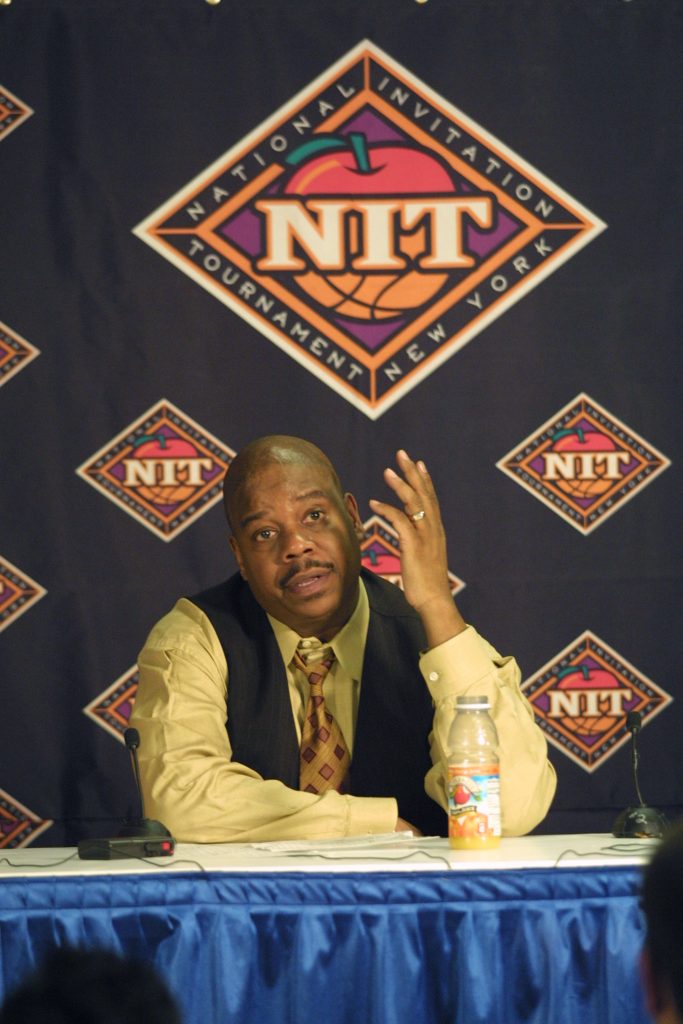
**NCAA-BOUND STREAKBUSTERS
Morgan’s second season began shakily. The Cyclones lost to both Northern Iowa and Iowa and began the Big 12 season 0-4. Then, magic kicked in. A home win over then-No. 13 Oklahoma ignited a hot streak that spanned seven games and chewed up four top-25 teams — included then-No. 20 Texas in Austin.
A few games before that road breakthrough Morgan had shared an emotional moment with Homan.
“He had kind of broken down with just me and him in the locker room and I kind of put my arm around him and he said, ‘I can’t believe I haven’t won an away game since I’ve been here,’” Morgan recalled. “And I said, ‘I promise you we’re going to win an away game.’”
Then came Texas. The champagne bottle got uncorked. Homan and his teammates celebrated — and even spent an extra night in Austin since the plane back to Ames was grounded one day because of mechanical issues.
“To finally break through that day against a good Texas team was a big deal,” Walters said.
A much bigger deal materialized two weeks later. The Cyclones carried their winning streak back into the Phog, but no phantoms awaited them that day.
Instead Stinson — via an utterly masterful 29-point performance — helped ISU charge past the second-ranked Jayhawks 63-61 in overtime. Stinson scored all seven of the Cyclones’ points in the extra frame and the mood in Lawrence went from devastation to elation.
“I thought we could win,” Morgan said, laughing heartily. “I’ll tell you a funny story I really haven’t told too many people. I know the assistant AD there pretty well because he’s a New York guy and at one point was at Hofstra. So you know how the teams come out and shoot before the games but the head coach, you never see him until right before the game because he’s sitting in the locker room? So he comes in and says, ‘Wayne, how you doing? How’s everything going? Great. Good to see you.’” And we’re talking and he says, ‘You’ve been on a great run. It’s too bad it’s going to end now, because you know you ain’t gonna win.’ So I just kind of said, ‘Oh.’ I didn’t react. I didn’t say anything. I just said, ‘Yeah, whatever.’ And the game was over and we won and I didn’t see him. I never forgot that. That was kind of funny.”
He did see a wild celebration — and an awestruck athletic trainer, Vic Miller.
“He just walked around like he was in a stupor saying, ‘I can’t believe we beat Kansas at Kansas, I can’t believe we beat Kansas at Kansas,’” Morgan said. “He said it like 15 times.”
The Cyclones finished 9-7 in the Big 12 that season and beat Minnesota in the opening round of the NCAA Tournament before running into a buzzsaw in the form of eventual champion North Carolina in round two.
“I was happy to get them back into the NCAAs,” Morgan said. “It’s just unfortunate. If we would have played about anybody else except (North) Carolina in the second round …
That sentence went unfinished, but despite the lack of a Sweet 16 appearance, Morgan seemed to have ISU back on the right track — two seasons after managing the chaos that mounted around Eustachy’s ouster. The style of play was still exciting. The results were solid. Morgan had helped steer the program forward.
“(Morgan) provided a different style of game — a little more offensive-minded, which my game was needing and lacking at that point,” Homan told Cyclone Fanatic last year. “So I think having the two coaches definitely helped.”
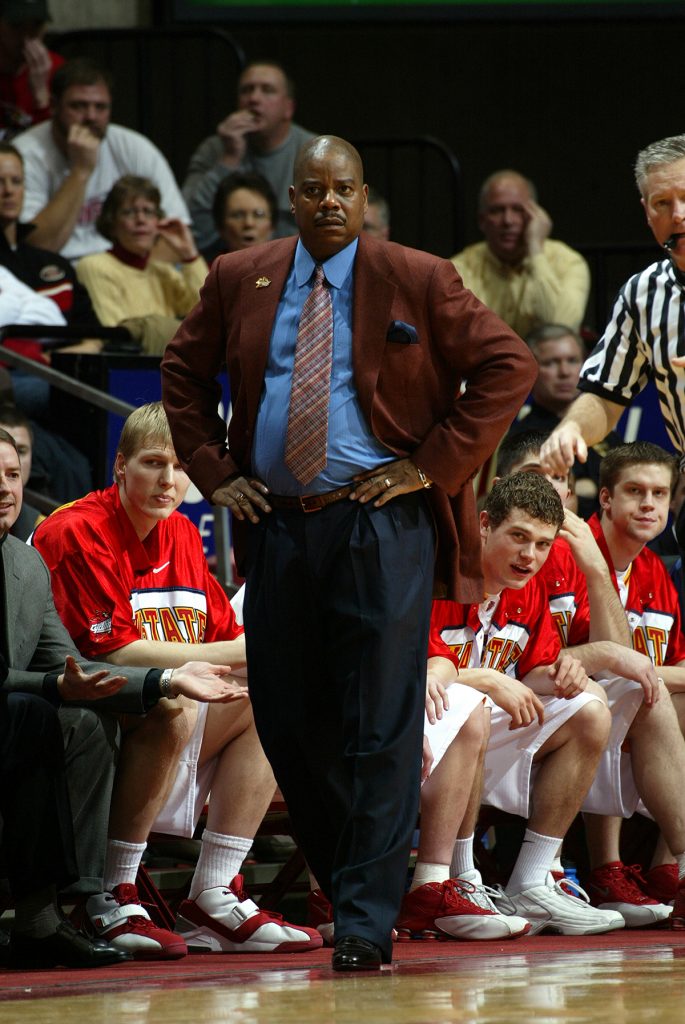
**ABRUPT ENDS AND NEW BACK-HOME BEGINNINGS
ISU went 16-14 in Morgan’s last season. He was fired that March and, again, declined to publicly comment on the circumstances surrounding his dismissal. But Morgan wasn’t done with Ames. He went on to form a successful satellite business — Mid-Iowa Satellite — in the early years of the technology. He ran the business for a number of years before another coaching opportunity emerged, this time, at Hofstra University in Long Island.
A friend, Rick Cassara, called Morgan to ask him to assist his son — a first-time head coach.
Morgan didn’t blink.
“I would rather do basketball than do the satellite business, let’s put it that way,” he said. “And I got back home, close to my mother and people I grew up with.”
So Morgan remains home, even after the stint at Hofstra ended in 2013. He hasn’t coached since and is uncertain if he ever will again. The love for the game hasn’t waned. Again, he lives with no regrets.
“I had a great, great run in basketball,” Morgan said.
He’s happy. He pays the bills. He turned a dream into a 30-plus year career — and he laughs like a champion.
But I finally asked him if he’d even consider dabbling in coaching to scratch that itch. Maybe volunteer somewhere? Maybe with young kids?
Oops.
“When somebody says, ‘A boy scout troop of 11-year-olds is starting a team, do you want to coach’? Morgan said, chuckling, “I’ll say, ‘No, I don’t.”


